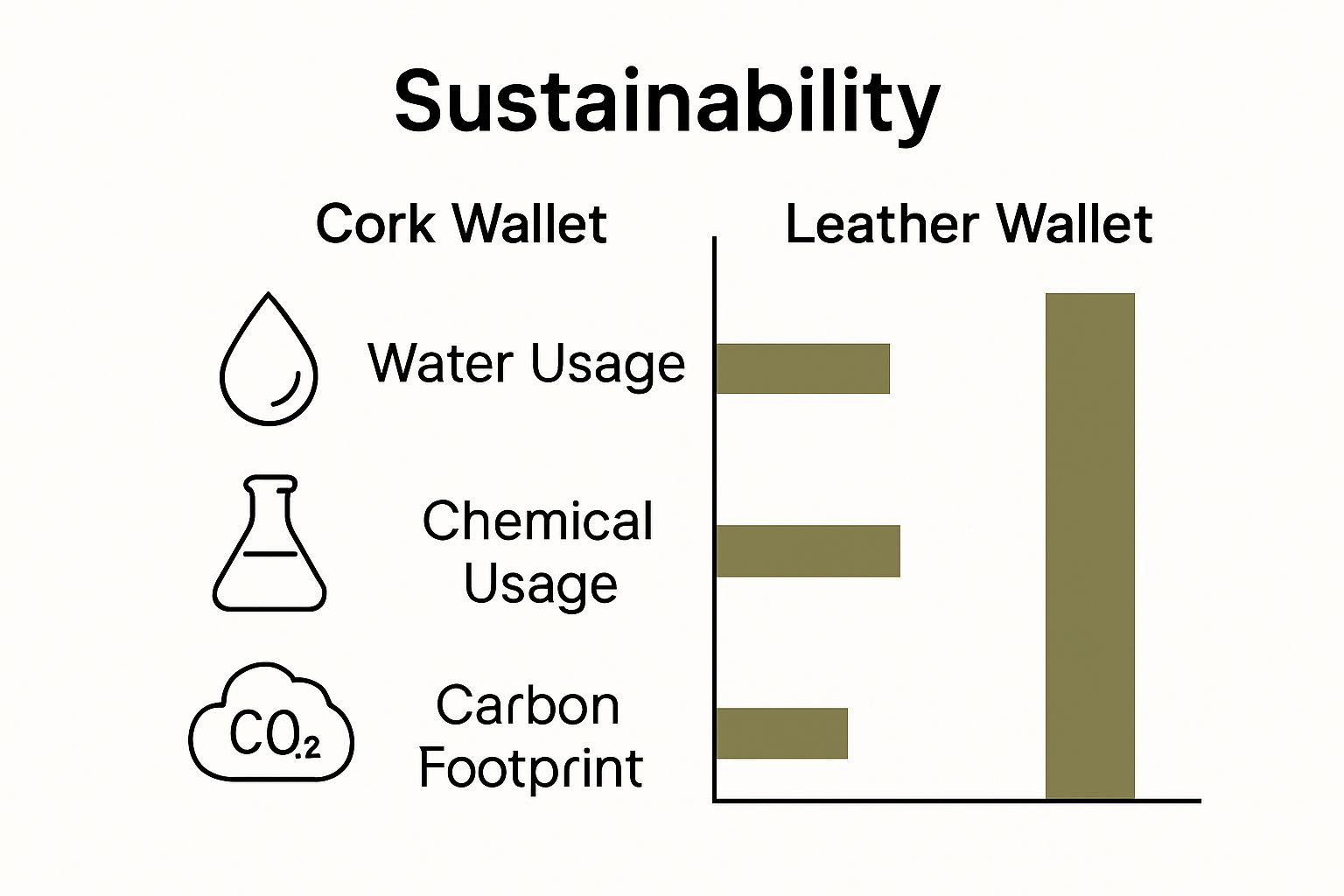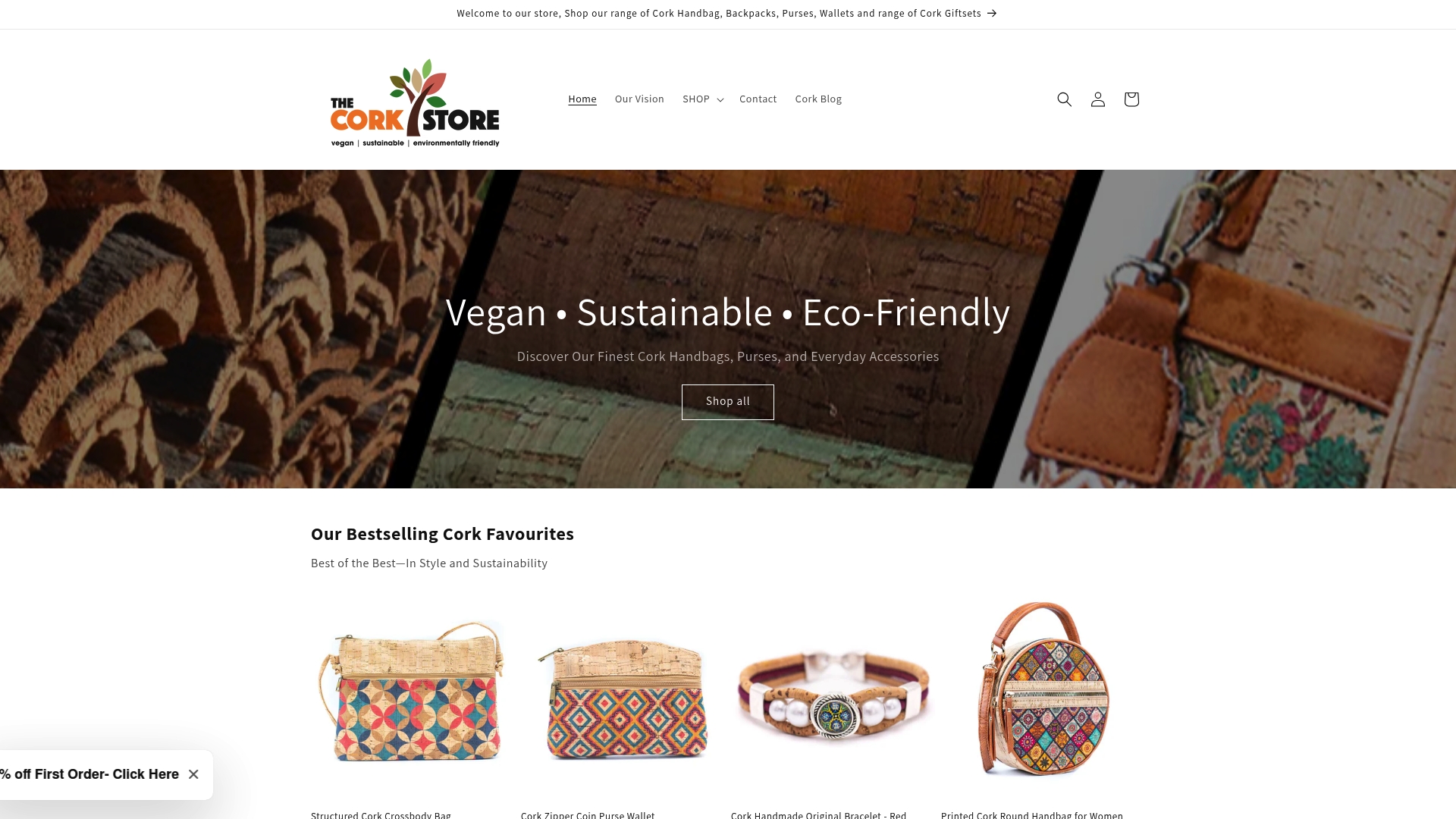
Understanding Why Use Cork Wallets for Eco-Friendly Living
Share
Cork wallets are turning heads for all the right reasons. Imagine this—a single cork oak tree can provide bark for up to 200 years without ever being cut down. Sounds unusual, right? While most folks think eco-friendly means sacrificing style or durability, cork wallets actually outperform conventional leather with their flexibility and waterproof properties.
Table of Contents
- What Are Cork Wallets And What Makes Them Unique?
- The Environmental Impact Of Choosing Cork Over Leather
- The Benefits Of Cork Wallets: Durability And Style
- How Cork Is Harvested And Processed For Wallets
- Cork Wallets In The Context Of Sustainable Fashion Trends
Quick Summary
| Takeaway | Explanation |
|---|---|
| Cork wallets are sustainably sourced | Made from the bark of cork oak trees, ensuring minimal environmental impact during harvesting. |
| They offer exceptional durability and water resistance | Cork wallets are lightweight, durable, and naturally resist moisture, ideal for daily use. |
| Choosing cork reduces environmental harm | Cork production contributes to carbon sequestration, unlike leather, which harms ecosystems and requires extensive resources. |
| Cork wallets reflect a shift in consumer values | They embody ethical consumption, appealing particularly to millennials and Gen Z prioritising sustainability. |
| Cork wallets are stylish and versatile | Available in various textures and colours, they blend fashion with ecological responsibility, proving sustainability can be chic. |
What are Cork Wallets and What Makes Them Unique?
Cork wallets represent a revolutionary approach to sustainable accessories, transforming an ecological material into practical, stylish personal storage solutions. Unlike traditional leather or synthetic wallets, these innovative accessories harness cork’s natural properties to create environmentally responsible products that challenge conventional design paradigms.
The Natural Origins of Cork Material
Cork originates from the bark of cork oak trees, primarily found in Mediterranean regions like Portugal and Spain. Sustainable cork harvesting practices ensure that trees remain unharmed during extraction, with bark carefully stripped by skilled workers every nine to twelve years. This unique harvesting method allows the tree to continuously regenerate, making cork one of the most renewable materials available.
The cork manufacturing process involves collecting bark, drying it, boiling it, and then cutting it into sheets suitable for wallet production. What makes cork remarkable is its inherent characteristics: lightweight, water resistant, flexible, and incredibly durable. These properties make cork wallets not just an accessory, but a statement about environmental consciousness.
Unique Properties of Cork Wallets
Cork wallets distinguish themselves through several extraordinary features that set them apart from conventional wallet materials:
- Exceptional Durability: Cork fibres are tightly compressed, creating a material that resists wear and tear far better than traditional leather.
- Natural Water Resistance: The cellular structure of cork provides innate protection against moisture, keeping your cards and cash secure.
- Lightweight Design: Compared to leather wallets, cork alternatives offer significantly reduced weight without compromising structural integrity.
For those interested in understanding more about sustainable accessories, read our comprehensive guide on cork innovation in accessories. These wallets represent more than just a storage solution they embody a commitment to ethical consumption and environmental stewardship.
The Environmental Impact of Choosing Cork Over Leather
Choosing cork wallets represents a significant ecological decision with profound implications for sustainable fashion and environmental conservation. By selecting cork over traditional leather, consumers make a powerful statement about their commitment to reducing environmental degradation and supporting regenerative production practices.
Carbon Footprint and Sustainability
Research from the World Wildlife Fund reveals that leather production generates substantial environmental challenges. Traditional leather manufacturing involves intensive resource consumption, including massive water usage, chemical treatments, and significant carbon emissions. Cork, by contrast, offers a dramatically different environmental profile.
Cork oak forests act as remarkable carbon sinks, absorbing approximately 14.7 tonnes of carbon dioxide per hectare annually. This means that cork production not only minimises environmental harm but actively contributes to carbon sequestration. The harvesting process preserves the living tree, allowing continuous bark regeneration and sustained carbon capture over decades.
Comparative Environmental Considerations
The environmental advantages of cork wallets extend beyond carbon sequestration.
 Key comparative factors include:
Key comparative factors include:
- Water Conservation: Leather production requires approximately 15,000 litres of water per kilogram, whereas cork harvesting is minimally water intensive.
- Chemical Usage: Traditional leather tanning involves toxic chemicals like chromium, which can contaminate water systems. Cork processing uses natural, non-toxic methods.
- Biodiversity Protection: Cork oak forests support complex ecosystems, hosting numerous plant and animal species.
Learn more about our commitment to vegan leather alternatives, which demonstrate how sustainable materials can revolutionise fashion without compromising style or functionality. By choosing cork, consumers actively participate in a global movement towards more responsible, environmentally conscious consumption practices.
Below is a comparison table highlighting the key environmental differences between cork and leather wallets, as described in the relevant section of the article.
| Environmental Factor | Cork Wallets | Leather Wallets |
|---|---|---|
| Carbon Footprint | Cork forests act as carbon sinks, capturing approximately 14.7 tonnes CO₂ per hectare per year | High carbon emissions during production due to livestock farming and processing |
| Water Usage | Minimal water required for harvesting | Approx. 15,000 litres per kilogram of leather |
| Chemical Usage | Natural, non-toxic processing methods | Involves toxic chemicals (e.g., chromium in tanning) |
| Impact on Biodiversity | Supports rich ecosystems in cork oak forests | Causes habitat loss and ecosystem disruption |
| Renewability | Bark regenerates; tree not harmed, can be harvested for up to 200 years | Animal-based; livestock must be raised or culled |
The Benefits of Cork Wallets: Durability and Style
Cork wallets transcend traditional accessory boundaries, offering a compelling fusion of aesthetic appeal and remarkable functionality. These innovative accessories challenge conventional perceptions about sustainable fashion, proving that eco-friendly choices can be simultaneously elegant and pragmatic.
Structural Durability and Performance
Material science research from the University of Porto highlights cork’s extraordinary mechanical properties. Unlike leather or synthetic materials that degrade rapidly, cork maintains its structural integrity through repeated use. The unique cellular structure of cork creates a material that is flexible yet resilient, capable of withstanding significant stress without compromising its fundamental characteristics.
The microscopic honeycomb-like composition of cork enables exceptional performance. Each tiny cell acts as a miniature shock absorber, distributing pressure evenly and preventing localised wear. This means cork wallets can endure daily handling, temperature variations, and mechanical stress while maintaining their original form and appearance.
Aesthetic Versatility and Design Innovation
Cork wallets represent a sophisticated intersection of sustainability and contemporary design. Modern manufacturing techniques allow for an impressive range of textures, colours, and finishes that appeal to diverse aesthetic preferences:
- Minimalist Elegance: Sleek, thin profiles perfect for conscious consumers
- Textural Complexity: Natural cork grain providing unique visual and tactile experiences
- Colour Diversity: Options ranging from natural cork tones to vibrant, professionally dyed variations
Explore our comprehensive range of cork accessories that demonstrate how sustainable materials can redefine personal style. By choosing a cork wallet, you are not merely purchasing an accessory but investing in a statement piece that reflects environmental consciousness and refined taste.
How Cork is Harvested and Processed for Wallets
The journey of a cork wallet begins in the sun-drenched forests of Portugal and Spain, where cork oak trees represent more than just a natural resource they embody a sophisticated ecological system of sustainable production. Understanding the intricate process of cork harvesting and transformation reveals why these wallets are so extraordinary.
The Harvesting Process
The Cork Confederation of Portugal explains that cork harvesting is a delicate, highly skilled craft passed down through generations of workers. Unlike timber logging, cork extraction involves carefully removing the bark without damaging the living tree. Skilled workers use specialised axes to strip the bark in a precise manner that allows the tree to continue growing and regenerating.
The first harvest occurs when a cork oak tree reaches approximately 25 years of age. Subsequent harvests happen every nine to twelve years, with each extraction allowing the tree to produce more high-quality bark. This regenerative process means a single cork oak can provide bark for up to 200 years, making it an incredibly sustainable resource.
Transforming Raw Cork into Wallet Material
Once harvested, the cork bark undergoes a meticulous transformation process that converts it from raw material to a wallet-ready textile. The stages include:
- Boiling and Cleaning: Raw bark is boiled to remove impurities and make it more flexible
- Cutting and Stabilising: Bark is carefully sliced into thin, uniform sheets
- Treatment and Finishing: Natural treatments are applied to enhance durability and texture
Discover more about our sustainable cork leather innovations and how traditional craftsmanship meets modern design. Each cork wallet represents not just an accessory, but a testament to ecological responsibility and artisanal skill.
The following table outlines the main stages involved in transforming raw cork bark into wallet-ready material, summarising the process described in the article.
| Stage | Description |
|---|---|
| Boiling and Cleaning | Raw bark is boiled to remove impurities and increase flexibility |
| Cutting and Stabilising | Bark is sliced into thin, uniform sheets suitable for wallet production |
| Treatment and Finishing | Natural treatments applied to enhance durability and surface texture |
Cork Wallets in the Context of Sustainable Fashion Trends
Sustainable fashion represents more than a fleeting trend it signifies a profound transformation in how consumers perceive and interact with their accessories. Cork wallets emerge as a quintessential symbol of this global shift towards environmentally conscious consumption, challenging traditional notions of style and functionality.
The Evolution of Eco-Conscious Accessories
Global Fashion Agenda research indicates that sustainable fashion is no longer a niche market but a mainstream movement. Consumers increasingly demand transparency, ethical production, and minimal environmental impact from their fashion choices. Cork wallets perfectly embody these evolving expectations, offering a sophisticated alternative to conventional leather and synthetic accessories.
The rise of cork accessories represents a strategic response to growing environmental concerns. Young consumers particularly millennials and Gen Z are driving this change, prioritising products that align with their values of sustainability, innovation, and responsible consumption. Cork wallets symbolise this generational shift, transforming accessory selection from a purely aesthetic decision to an ethical statement.
Sustainable Fashion Principles in Practice
Cork wallets exemplify key sustainable fashion principles through their production and design:
- Circular Economy Integration: Utilising renewable materials with minimal waste
- Reduced Carbon Footprint: Manufacturing process significantly less environmentally damaging compared to traditional leather production
- Ethical Material Sourcing: Supporting local communities and preserving ecological systems
Explore our comprehensive guide to eco-friendly fashion accessories and discover how innovative materials are reshaping the fashion landscape. Cork wallets are not just accessories they are a testament to conscious consumerism and the potential for style and sustainability to coexist harmoniously.

Make Cork Wallets Part of Your Eco-Friendly Lifestyle
Are you ready to move beyond the environmental drawbacks of traditional leather and synthetic accessories? If you are seeking accessories that truly embody durability, style, and real sustainability, the advantages of cork wallets, as covered in this article, could transform how you shop and live. By switching to cork, you address common frustrations such as harmful resource use, lack of transparency, and short-lived materials. There is no need to choose between looking good and making responsible choices. With cork wallets, you embrace water resistance, ethical sourcing, and a renewed commitment to the planet.

Take the step now and explore our full collection of beautifully crafted, cruelty-free cork wallets and accessories. Every piece at The Cork Store is designed for eco-conscious living, helping you turn your values into everyday actions. Discover more about the benefits and innovations behind cork in our in-depth blog on cork innovation in accessories. Ready to make a real difference? Shop the latest sustainable options today at https://thecorkstore.co.uk and see how easy it is to combine style and environmental care. Act now to join a growing movement for responsible fashion and make a positive change with every purchase.
Frequently Asked Questions
What are cork wallets made from?
Cork wallets are made from the bark of cork oak trees, transformed into durable and flexible sheets through a careful harvesting and manufacturing process.
Why are cork wallets considered eco-friendly?
Cork wallets are eco-friendly because they are made from a renewable resource, involve minimal water and chemical use compared to traditional leather production, and help to preserve cork oak forests, which act as significant carbon sinks.
How do cork wallets compare to leather wallets in terms of durability?
Cork wallets are exceptionally durable due to their tightly compressed fibres, which resist wear and tear better than traditional leather. They maintain their structural integrity and do not degrade quickly with regular use.
Are cork wallets water-resistant?
Yes, cork wallets naturally have water-resistant properties due to the cellular structure of cork, which provides protection against moisture and keeps your cards and cash secure.
